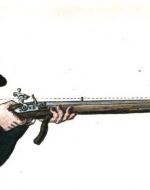Created by Laci Dezern on Wed, 10/02/2024 - 22:54
Description:
The British Army Baker Rifle was primarily used in the first fifteen years of the 19th century. It was depicted in the “Regulations for the Exercise of Riflemen and Light Infantry and the Instructions for their Conduct in the Field. This manual was reprinted throughout the Napoleonic Wars and remained the standard rifle firing drill” (Access Heritage). As there were many wars occurring during this time period, it was important to keep track of which guns were used for what purposes. Especially since different militias tended to have different guns due to fighting in different conditions. “the rifle regiments were concerned their recruits were chosen for their qualities” (Petch). Those selected had to know how to read and write, as well as train under vastly different positions and techniques to be prepared for any situation. The guns were produced until 1838 until they were replaced by more modern guns.
Only men were allowed to join the military, especially the navy, as women were too delicate and required too many “accommodations on board, such as women ought to have” (McMaster). The only reason the idea of women joining the militia was considered was because women were not allowed to work at all. If they were poor or had a poor social status, there was nothing they could do to fix their situation past marrying a wealthy and upper-class man. Austen herself showed interest in the military as her brothers were a part of it. Rules were in place to have even the wife of a navy admiral living on the ship. One may have been the refusal to let the women hold or be in the presence of guns, as guns were typically considered “strongly masculine items” as Freud claims they are “obviously phallic” (Derry). Women were not supposed to be around such “unclean,” manly items as they were responsible for raising the children and taking care of the home. They did not have the social understanding to want to understand war, nor were they supposed to have any political say on what happened during wartime.
Works Cited
Derry, Stephen. Freud, the Gothic, and Coat Symbolism RN Northanger ..., www.jasna.org/persuasions/printed/number18/derry.pdf. Accessed 8 Oct. 2024.
“Loading and Firing the British Army Baker Rifle, 1799-1815.” Access Heritage: Military Swords, Flintlock Muskets, History Uniforms, www.militaryheritage.com/bakerrifle.htm. Accessed 8 Oct. 2024.
McMaster, Rowland. “‘I Hate to Hear of Women on Board’: Women Aboard War Ships " Jasna.” Jane Austen Society of North America, jasna.org/publications-2/persuasions-online/vol36no1/mcmaster/. Accessed 8 Oct. 2024.
Petch, Alison. “Object Biographies.” Baker Rifle 1884.27.39, web.prm.ox.ac.uk/rpr/index.php/objectbiographies/68-baker-rifle-18842739/index.html#:~:text=The%20Baker%20Rifle%2C%20which%20was,distribution%20as%20late%20as%201841. Accessed 8 Oct. 2024.
Presenting or Aiming a Baker Rifle. 1804.


